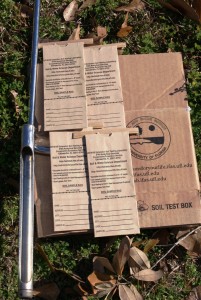Matthew Orwat, Horticulture Agent I, Washington County Extension
Last week’s warm spring-like weather has reminded producers that it is time to prepare this year’s fertility management plan. This reminder is timely because there is still time to prepare for the growing season ahead. Before producers add fertilize or lime, however, it is vital to understand the condition of the soil.
One of the easiest methods to assess the condition of a production area’s soil is to obtain a soil test. Soil tests effectively determine the pH and nutrient levels of the soil in a given area. It is essential that the test be collected correctly so that it accurately reflects the nutrient levels in the production area. All that is needed to take an accurate soil sample is shovel or soil probe, and a plastic bucket. Metal buckets will contaminate soil sample results, so a plastic bucket is an absolute requirement. To collect your soil sample, follow these guidelines:
- Identify the production area(s) to be sampled. Use one soil sample bag for each area. Uncharacteristic or problem areas (such as depressions, etc.) within the production area should be sampled separately.
- Using a shovel (or soil probe), remove soil from a number of locations within the production area. The more soil collected from the sample area, the more accurate the results will be. Soil should be removed from the top 6 inches.
- Discard any plant material (such as leaves or roots) and deposit the soil into the plastic bucket. When you are done collecting soil, mix all the soil in the bucket to ensure it is well blended. You will have much more soil than you need to fill the sample bag, but a well-mixed representative sample is important for good results.
- Spread the soil from the bucket onto newspaper and allow it to dry thoroughly. This may take up to 24 hours. A dry sample is very important because moisture may affect the results.
- Once dry, pack approximately 1 pint of soil into the soil sample bag (filled to the dotted line) These bags are available free from your county Extension office..
The best soil test value is the $7.00 soil test which includes analysis of phosphorus (P), potassium (K), calcium (Ca), and magnesium (Mg) in addition to soil pH and liming requirement. The proper form should be filled out and mailed to the University of Florida with the soil sample and payment. Results will usually be sent back within 1-2 weeks. Click here to view a sample soil test report.
The soil sample report will include lime and fertilizer requirements. Remember that the recommended fertilization rates in the report are in pounds of nutrient, not pounds of fertilizer. For example, if it is recommended that the producer apply 50 pounds of nitrogen per acre and their fertilizer analysis is 10-10-10, they would need to apply 500 pounds of fertilizer. This is because 10-10-10 fertilizer contains 10% nitrogen.
For more information, consult your local county extension office, visit the UF/IFAS Extension Soil Testing Laboratory website, or the UF/IFAS publication Standardized Fertilization Recommendations for Agronomic Crops.
- Steps to Remedy Non-Productive Pecan Orchards - June 30, 2023
- If Not Disease, Then What? Abiotic Vegetable Disorders - June 24, 2022
- Dormant Sprays Protect Fruit Trees from Future Insects and Diseases - January 28, 2022

